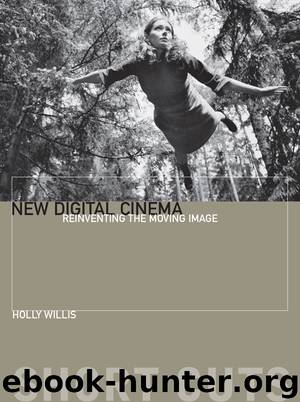New Digital Cinema by Holly Willis

Author:Holly Willis
Language: eng
Format: epub
Publisher: Wallflower Press, a division of Columbia University Press
FIGURE 7 Robert Bradbrook’s Home Road Movies (2001)
More significantly, however, these live-action/graphic hybrids point to cultural anxieties about who and where we are in an increasingly mediated world. They point to the potential seamlessness of real and fake worlds and, by emphasising their constructedness, spark a sense of wonder, but also of empowerment, allowing us to consider representations of space and time that refuse the sense of dissolution caused by giant networks of control; they also offer methods for constructing our own ensembles of space and time.
Diagrams and flat spaces
A third category of short design videos is the entirely graphic or diagrammed animated project. Positioned in the very narrow gap between art and commerce, these projects enact a form of reduction, using the international language of logos and graphics to illustrate visually rather than to tell verbally. Johnny Hardstaff’s The History of Gaming (2000), for example, is composed of a long, horizontal parade of icons charting the evolution of gaming from the 1970s forward. Set to a Minnie Riperton song, the piece animates the icons, creating a visual timeline not just of gaming, but of its visual iconography. Hardstaff, who studied graphic design in London at St. Martin’s, originally created the piece for himself. However, it was eventually purchased by Sony PlayStation, and Sony’s PS logo was appended at the timeline’s conclusion, marking not only the platform’s participation within a larger cultural history, but blurring the very evanescent boundary between art and commercials. The hazy delineation characterises much of this work, as companies such as Nike offer funds to artists to create moving image work based on their products.
The work of the French collective H5, founded in 1996 by Ludovic Houplain and Antoine Bardou-Jacquet, has also been central to the evolution of the graphics-driven video form. With the addition of Herve De Crecy, Rachel Cazadamont, François Allaux and Fleur Fortuné, the company expanded in number and creative form, from creating logos, corporate identities and other marketing tools for a long list of clients into music videos, making their first video for ‘The Child’ (1999), a track by Alex Gopher. The innovative video takes viewers on a rollercoaster ride through the busy streets of Manhattan, rendered here entirely as text; the video becomes an amusing instance of concrete poetry, brought to fluid motion. Very similar in its text-based graphic representation to Jeffrey Shaw’s 1988 interactive project titled The Legible City, in which participants pedal a stationary bicycle that seems to navigate through the graphical depiction of a city created out of text, the video nevertheless pushed text and typography to the fore as yet another tool in the expanding visual repertoire of music video directors. Bardou-Jacquet left the company in 2002, but H5 has continued to create inventive videos, including the 2002 video for ‘Remind Me’ by Royksopp, in which a young woman’s entire day is mapped graphically, detailing the architectural construction of her home, mapping her route via transportation systems to work, and the path of her food, from farm to restaurant to digestion.
Download
This site does not store any files on its server. We only index and link to content provided by other sites. Please contact the content providers to delete copyright contents if any and email us, we'll remove relevant links or contents immediately.
| Body Art & Tattoo | Calligraphy |
| Ceramics | Conceptual |
| Digital | Erotic |
| Film & Video | Glass |
| Graffiti & Street Art | Illuminations |
| Installations | Mixed Media |
| Mosaic | Prints |
| Public Art | Video Games |
Kathy Andrews Collection by Kathy Andrews(11730)
Thirteen Reasons Why by Jay Asher(8794)
The Red Files by Lee Winter(3368)
How to Do Nothing by Jenny Odell(3232)
The Genius of Japanese Carpentry by Azby Brown(3224)
Stacked Decks by The Rotenberg Collection(2811)
Tattoo Art by Doralba Picerno(2600)
Champions of Illusion by Susana Martinez-Conde & Stephen Macknik(2414)
The Artist's Way Workbook by Cameron Julia(2196)
The Art of Doom by Bethesda(2106)
Calligraphy For Dummies by Jim Bennett(1992)
Creative Character Design by Bryan Tillman(1888)
Botanical Line Drawing by Peggy Dean(1812)
Wall and Piece by Banksy(1781)
The Art of Creative Watercolor by Danielle Donaldson(1777)
One Drawing A Day by Veronica Lawlor(1767)
Art Of Atari by Tim Lapetino(1750)
Pillars of Eternity Guidebook by Obsidian Entertainment(1625)
Happy Hand Lettering by Jen Wagner(1558)
